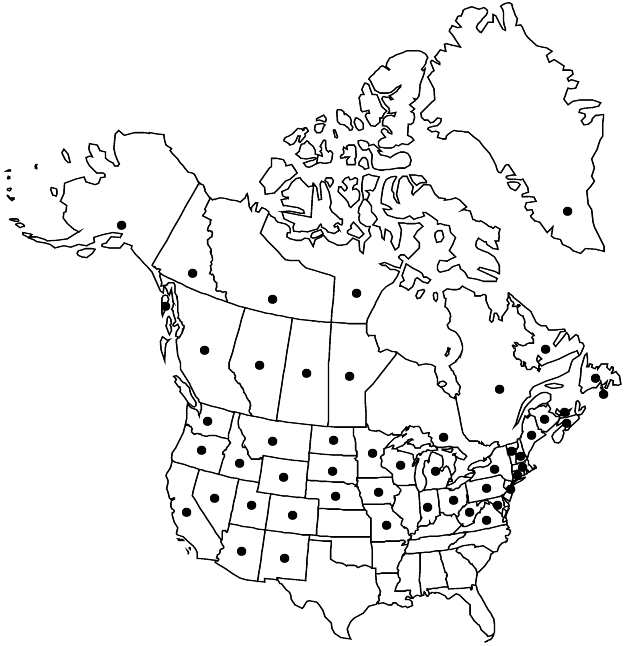Cerastium arvense
Sp. Pl. 1: 438. 1753.
Plants perennial, clumped and taprooted, or mat-forming and long-creeping rhizomatous. Stems: flowering shoots often decumbent proximally, 5–20(–30) cm, glandular-pubescent distally, pilose-subglabrous, deflexed or spreading proximally; non-flowering shoots present; small tufts of leaves present in axils of proximal leaves. Leaves not marcescent, sessile, ± spatulate proximally; blade linear-lanceolate to lanceolate or narrowly oblong, 4–30 × 0.5–6 mm, apex acute, rarely obtuse, subglabrous to softly pubescent, sometimes glandular. Inflorescences lax, 1–20-flowered cymes, pubescence short, glandular; bracts lanceolate, margins narrow, scarious, glandular-pubescent. Pedicels curved just below calyx, 5–30 mm, 1–6 times as long as sepals, glandular-pubescent. Flowers: sepals narrowly lanceolate to lance-elliptic, 3.5–7 mm, margins narrow, softly pubescent; petals obovate, 7.5–12.5 mm, ca. 2 times as long as sepals, apex 2-fid; stamens 10; anthers 0.8–1.1 mm; styles 5. Capsules cylindric, curved, 7.5–11.5 × 2.5–4 mm, (1–)1.5–2 times as long as sepals; teeth 10, erect, margins convolute. Seeds brown, 0.6–1.2 mm diam., tuberculate; testa not inflated. 2n = 36, 72, (108, Europe).
Distribution

Alta., B.C., Man., N.B., N.S., N.W.T., Nfld. and Labr. (Nfld.), Nunavut, Ont., P.E.I., Que., Sask., Yukon, Alaska, Ariz., Calif., Colo., Conn., Idaho, Ind., Iowa, Maine, Mass., Md., Mich., Minn., Mo., Mont., N.Dak., N.H., N.J., N.Mex., N.Y., Nebr., Nev., Ohio, Oreg., Pa., S.Dak., Utah, Va., Vt., W.Va., Wash., Wis., Wyo., Worldwide.
Discussion
Subspecies 2+ (2 in the flora).
The infraspecific taxonomy of Cerastium arvense is subject to many different interpretations. While many subspecies have been recognized, the “actual” number is uncertain because of worldwide distribution, wide range of variation, and conflicting taxonomies.
Selected References
Key
| 1 | Taproot absent, plant strongly rhizomatous with long-creeping shoots; flowering stems usually 25-30 cm, often purple pigmented proximally, pubescence eglandular (glandular hairs present in inflorescence), soft, short or subglabrous; sepals 5-7 mm; anthers 1-1.1 mm; petals usually turning brown when dried | Cerastium arvense subsp. arvense |
| 1 | Taprooted or shortly rhizomatous, forming clumps; flowering stems usually 5-20 cm, green or straw colored, glandular-pubescent; sepals 3.5-6(-7) mm; anthers 0.8-0.9 mm; petals usually remaining white when dried | Cerastium arvense subsp. strictum |